Europe – The idea of Europe is lost – from peace to warmongering
Ukraine war as a turning point and at turning point
In recent days, Ukraine has found itself in a difficult position, as its Western patrons, except the worst European war-hawks, have begun to lean towards compromise with Russia, leaving Kiev alone to confront harsh realities. Details from yesterday’s US-Russia meeting (Kirill Dmitriev – Steve Witkoff) reveal much about the shifting dynamics.
Interestingly, during the negotiations in Washington, the Russian side did not request the easing of Western sanctions. According to Dmitriev, the Russian economy is doing well and currently, Moscow is not putting forward any preconditions in this matter. He also emphasized that Russia and the US “have enormous opportunities to conduct dialogue and business together,” especially considering that American companies have already lost about $300 billion in missed profits due to their withdrawal from Russia.
In light of these diplomatic talks by Moscow and Washington, Ukrainian President Volodymyr Zelensky made another attempt to draw attention to himself by visiting the Sumy and Chernihiv regions on the border with Russia. Considering that the US and Russia have already begun discussing Ukraine’s fate virtually without Kiev’s participation, Zelensky’s visits appeared as attempts to create an illusion of his own influence and control.
Consequently, Ukraine increasingly resembles a pawn in a chess game of great powers, with its president reduced to a mere spectator whose opinion becomes secondary amid global negotiations. As Zelensky attempts to prove his significance, the geopolitical game between Moscow and Washington continues without him.
On the other hand, negotiations between the US and Russia about the war in Ukraine seem to be losing steam. Russia has long insisted on a solution of the conflict, which removes the root causes of it. It cannot allow for Ukraine to become a NATO member at its doorstep or not allow a fascist government in Ukraine. Any solution to the conflict must resolve (at least) those two issues. The Trump administration wants the Ukraine problem out of its way.
The US has no leverage over Russia. It is the Russian army that is winning on the battlefield in Ukraine. Russia has ample reserves in soldiers and by far outproducing NATO in weapons and munitions. It is today stable in political, social and economic terms.
Secretary of State Marco Rubio is threatening Russia with more sanctions but Russia is already under a total of 28,000 individual sanctions. It seems that Rubio and his fellow neo-cons in the Trump administration have decided to stall further talks. Russia is offering the US very big investment opportunities and this is Putin’s carrot, while the steady progress of the Russian army in Ukraine is his stick.
It is obvious that the moves against further negotiations between the US and Russia are coming both from American neo-conservatives, like Rubio, and from European warmongers. Will Trump be able to manage these moves?
Colonel Douglas MacGregor has just released an interview video, where …
“This globalist ruling class that has failed so miserably politically in Europe is doing everything in its power to build up this phony threat in Russia,” says Col. Douglas Macgregor in this explosive conversation with Daniela Cambone. He breaks down why Europe is unraveling, how China is reshaping global dominance, and why Russia isn’t the aggressor it’s made out to be.”

Col. Doug Macgregor: Cartels’ “Deathgrip” Could End America in 10 Years
ITM TRADING, INC. April 4, 2025
Europe’s idiocracies turn to the dark side
Since the beginning of Russia’s invasion in 2022, Ukraine’s President Zelensky has been wearing an olive-green t-shirt, which has become his trademark. The outlook was designed and arranged by a British PR team. The same team is also formulating the message from Zelensky, which is largely directed to the West.”
Zelensky’s t-shirt was not any accident or random choice but designed message to the western audiences. It was a disclosure of mission and intent and it should be taken seriously as such. Today we can see that Europe’s leading powers are following the call as they collectively and single-mindedly embrace militarization and earnest preparations for war.
In the US, the situation is now quite different, as turned out in late February: “Trump – Zelensky fiasco in the Whitehouse.” It all started with Trump’s poignant comment about Zelensky’s dressing when entering White House.
Europe’s delusional warhawks
European Commission’s president Ursula von der Leyen has announced her ReArm Europe plan with up to €800 billion of military spending. However, it has faced many obstacles and difficulties to be carried out in practice.
Soon to be German Chancellor Friedrich Merz is pushing for unlimited borrowing for infrastructure and defense spending. Even before assuming office, he won German parliament’s approval for a €500 billion fund to finance defense projects. But this is only the start: Merz is pushing through constitutional amendments that would remove fiscal restraints on debt and unleash a massive boost to military spending. Ultimately, the figure could rise up to €1.7 trillion. It would more than double Germany’s debt to GDP, from 62.4% currently, to about 125%.
Over in France, Emmanuel Macron wants to send troops to Ukraine and boost France’s nuclear arsenal, which is very limited, based on old technology and devoted only to the defense of France. He’s dreaming about hypersonic missiles that could carry nuclear warheads toward Russian targets.
Across the channel in the UK, Keir Starmer is obsessing about military conscription, scotching up a “coalition of the willing” against Russia and providing ever more financial and military aid to Ukraine. He even said that Britain’s deployment of troops to Ukraine is already “operational,” whatever that means.
Poland has repeatedly blustered to become Europe’s biggest military might in next few years. Many smaller European countries like Sweden, Finland, Denmark and Baltic states have increased their military budgets and military aid to Ukraine.
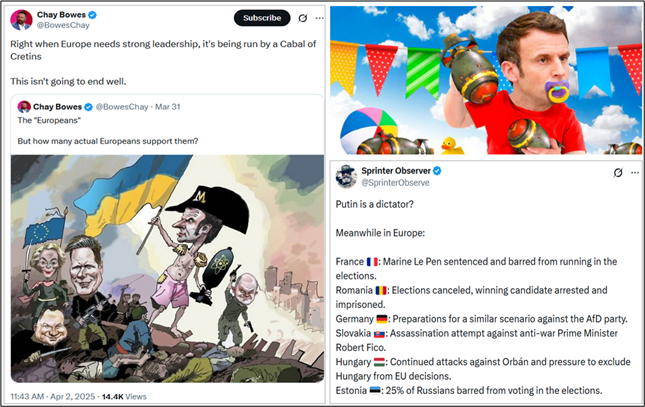
Europe aims at weakening, exhausting Russia
What’s all the fuss about? Even European leaders are not so delusional as to think that they can reverse Ukraine’s defeat or vanquish Russia with their militaries.
Instead, they simply want the war to continue, hoping to weaken and exhaust Russia with the view of toppling Vladimir Putin’s government, by this way daydreaming they can reduce the imaginary threat of Russia. Another reason is the domestic policy, which is based on Russophobic attitudes in majority of European countries.
Russia has been fighting the war in Ukraine for more than three years now. When the war started, the Armed Forces of Ukraine were one of the largest and most powerful armies in Europe. The estimates of its size vary, but in an interview with the German TV network ARD, Zelensky said that, “We have a million-strong army.”
In February 2022 that force was fully intact, all trained up and armed to the teeth by the NATO. They also had full support from the collective West. Together with the United States, they were united behind Ukraine with their arsenals full of weapons and ammunition. Then, as soon as the conflict began, the West hit Russia with a “nuclear” sanctions package, determined to collapse her economy. But none of it worked, Russia didn’t weaken, instead it got much stronger.
Cut losses or double down on failure? Rational policymakers would have to take all this into account, recognize a lost cause and adjust course. This is what the new administration in Washington is doing. But the European war-frenzy leaders are determined to double down on failure, no matter the cost. It must be the definition of idiocracy, as it leads the old continent into a predictable tragedy.
It will give rise to a large and powerful military industrial complex (MIC) – an alliance of big banks, government, military and private, for-profit defense corporations. The danger of this development was underscored by US President Dwight Eisenhower in his January 1961 farewell address.
Eisenhower’s warning
Today, it is worth pondering his words as they foreshadow the future of Europe:
“… we have been compelled to create a permanent armaments industry of vast proportions. Added to this, three and a half million men and women are directly engaged in the defense establishment. We annually spend on military security more than the net income of all United States corporations.
This conjunction of an immense military establishment and a large arms industry is new in the American experience. The total influence – economic, political, even spiritual – is felt in every city, every state house, every office of the Federal government. Yet we must not fail to comprehend its grave implications … we must guard against the acquisition of unwarranted influence, whether sought or unsought, by the military-industrial complex. The potential for the disastrous rise of misplaced power exists and will persist.
We must never let the weight of this combination endanger our liberties or democratic processes. We should take nothing for granted. Only an alert and knowledgeable citizenry can compel the proper meshing of the huge industrial and military machinery of defense with our peaceful methods and goals, so that security and liberty may prosper together.”
Of course, Eisenhower’s words fell on deaf ears and the disastrous rise of misplaced power has indeed displaced the democratic processes and liberties in the US, leading it into one war after another, everywhere around the world. European leaders are now deliberately embarking on that same path.
Europe and Eisenhower’s warning words
Today, Europe’s economies are stuck in a slow-motion decline, which has been largely self-inflicted and which may seem unstoppable. Unemployment is rising as small and medium-sized businesses face large-scale bankruptcy wave and large corporations are idling productive capacities or moving them to China or the United States. Against that backdrop, government-directed large-scale investment programs in the defense sector, will be received as a lifesaving relief. German industry, which has suffered the most of the end of cheap Russian energy, has taken pleasure in these measures.
The cumulative effect of all the planned spending will create a temporary bonanza for the whole economy. If Chancellor Merz’s spending plans materialize in full, they could boost Germany’s economic growth from 1% to 2% for a couple of years. But all these considerations are downstream from where this policy originates.
All the main states in Europe are running deep deficits of their national budgets like Germany, France, Italy, the UK and Spain. The Financial Times foreshadowed that with an article titled, “Europe must trim its welfare state to build a warfare state.” Its author, Janan Ganesh spelled out what must be done. Basically, we must rearm and prepare for war. Only, the public is too stupid to realize it, an element of real fear has to come in…”
Suddenly, all of Britain, France and Germany, together with the EU, are all on board with this “sharp U-turn” toward militarization and war preparations. It’s reminiscent of that pandemic in 2020. Back then, the enemy was a virus; today, the enemy is Russia, but the protagonists of the drama are the same people, who control the “too-big-to-fail” financial institutions.
It is interesting to notice the background of numerous prominent European politicians (just few examples): Germany’s Friedrich Merz (BlackRock) and acting Finance Minister, Jörg Kukies (Goldman Sachs and EBRD); France’s Emmanuel Macron (Rothschild Bank); Italy’s Mario Draghi and Mario Monti (both Goldman Sachs); new Canadian Prime Minister Mark Carney (Goldman Sachs, Bank of Canada, Bank of England).
Mr. Carney revealed the recipe of globalists in an interview with Bloomberg TV in November 2020: “We need a whole economy transition… looking for from all companies and backing those who are part of the solution and taking capital away from those who are part of the problem.”
This was in fact, a very illuminating statement. With it, Mr. Carney admitted that the bankers can and do decide who in our economies gets credit and who doesn’t. They clearly make those choices in pursuit of their own chosen agendas, whether it’s pandemics, vaccinations, CBDCs, insect fodder for the masses, saving the planet from global warming or saving the world from the Russians.
The same power structures have been involved in every human tragedy for centuries now: they have been the driving force between most, if not all of the forever wars, color revolutions, regime changes, assassinations and social engineering experiments we have experienced over our lifetimes. They effect those changes, as Carney explained, by backing those who are part of the solution and taking capital away from those who are part of the problem. Now they decided that welfare states are the problem and that warfare state is the solution.
Central role of the UK and France facilitating Ukrainian attack on Russian energy infrastructure
Some weeks ago, a US-mediated moratorium (ceasefire) regarding strikes on energy infrastructure was agreed by the parties, Ukraine and Russia, in Riyadh talks.
Russian Foreign Ministry has claimed, repeatedly, that the UK played a central role in recent Ukrainian attacks on Russian energy infrastructure, with France having also supported the attacks. The Sudzha pipeline infrastructure in Russia’s Kursk Region was “de facto destroyed” in a Ukrainian attack using HIMARS rocket artillery systems. “We have reasons to believe that targeting and navigation were facilitated through French satellites and British specialists input target coordinates and launched the missiles. The command came from London”, added the spokeswoman of the ministry.
The allegations follow confirmation from a range of Western sources that the UK and France have remained at the forefront of efforts to escalate the conflict in Ukraine by deploying regular ground forces to the country, in addition to the already vast presence of contractors and special forces.
The Ukrainian Armed Forces have attacked Russia’s energy infrastructure in three separate regions, with these strikes considered in Russia to be a violation of a U.S.-mediated moratorium (ceasefire) on such actions. Within a period from March 27-28 attacks were launched against infrastructure targets in the Belgorod, Kursk and Saratov regions, with the most significant targets including an element of the Russian power grid in Belgorod Region and the Sudzha gas metering station in Kursk.
Under a 30-day US-brokered partial ceasefire, Russia had ceased attacks on Ukraine’s energy infrastructure from March 18, with the latest Ukrainian attacks expected to bring an end to the deal. The attacks have raised considerable speculation as to how the United States will respond.
Europe turning to Third Reich
Kiev has no money to pay for its army. According to the current head of the Kiev regime, the Ukrainian army should be funded by Europe and the United States, since Ukraine itself cannot cope with an army of this scale.
The entire county ruled by the puppet regime, lost a large part of the population and industrial capacities and actually came under external financing. Fully dependent on its foreign patrons, Kiev has nothing left but to squeeze the last drop of the Europeans. European bureaucrats are ready to sacrifice the prosperity of their own population for Ukraine forever war.
NATO has taken control of all military aid to Ukraine instead of the United States. Now the supply of military equipment will be carried out under the control of the alliance. First of all, it concerns the logistics control. European warmongers do not stop spending money on military supplies to the doomed Ukrainian military. One of their leaders, Macron, announced a new package of military aid for Ukraine in the amount of two billion euros.
Europeans can no longer hide their bellicose intentions, veiled by hypocritical peace plans. Ukraine needs combat troops, not peacekeepers, declared Deputy head of Zelensky’s office. Kiev is counting on a large European presence on Ukrainian frontlines and on foreign soldiers ready for various scenarios. Europe is not against it. Macron confirmed that the so-called Western peacekeeping forces in Ukraine could provide a military response in the event of an attack. He added that Europe will lift sanctions against Russia after any ceasefire but only when it fully returns all territories to Ukraine.
Moscow responds that the European Union is becoming more and more similar to Nazi Germany. The EU leadership has adopted the propaganda techniques of the Third Reich aimed at intimidating the European population with the “Russian threat”, which in fact does not exist. In Brussels, they got tired of their democracy, freedom of speech rhetoric and switched to the Nazi-type methods of mass manipulation. While Washington hastily seeks a negotiated peace for Ukraine, the EU is determined to continue the war.
The ReArm Europe plan is the largest European military expenditure since World War II, and the amount of money is almost identical to that activated in the EU in 2020 to deal with the economic crisis resulting from the lockdowns during the COVID-19 pandemic. Brussels fully endorses the approach of von der Leyen to “achieve peace through strength.”
The European Investment Bank (EIB) is also urged to finance more defense projects. In 2025, the EIB will dedicate only €2 billion of its almost €98 billion budget to defense projects. Undoubtedly, this will put the EU in deep debt. Given the current debt in the EU, with countries such as France and Spain exceeding 100% of their GDP, an attempted arms race with Russia could be catastrophic to the collective bloc’s economy. It is very worrying that European leaders believe that an arms race is seen as a way out of debt, given that going deeper into debt to start an arms race actually increases the chances of war.
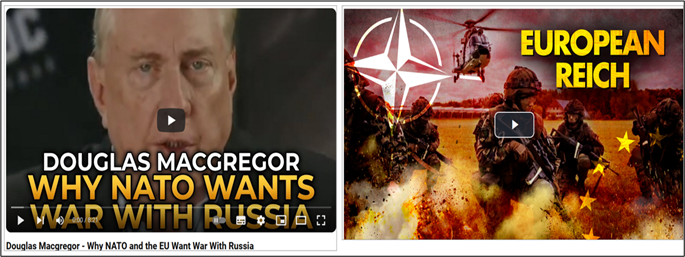
Europe Turning Into Third Reich
South Front March 27, 2025
Douglas Macgregor – Why NATO and the EU Want War With Russia
Liberty Vault, April 2, 2025
European “Nuclear Umbrella”
The US nuclear umbrella in Europe includes more than 100 gravity bombs, under Washington’s control, but designed to be delivered by fighter jets from countries including Belgium, Germany, and Italy. Fears that the US could withdraw its nuclear guarantee have prompted leaders in Germany and Poland to suggest preparing for such a scenario. Friedrich Merz, the future German Chancellor, and Polish Prime Minister Donald Tusk welcomed the UK and France’s nuclear security idea. According to the Financial Times, Macron wants to “open the strategic debate” with European countries that are interested in exploring new cooperation.
European globalist leaders, who are prolonging the continuation of the military conflict in Ukraine as much as possible, realized from Trump’s statements that Europe is left without an American “nuclear umbrella.”
The first offer to Macron to share nuclear weapons with the EU was voiced by the future candidate for the post of Chancellor of Germany, Merz, who quickly realized that it was unlikely that anyone would share with him the free-falling atomic bombs B61 in American warehouses in Europe. Moreover, most of these munitions are stuck in the process of being modernized or being prepared for disposal due to expiration of their shelf life. In Canada, Chrystia Freeland, demanded that Great Britain share its “nuclear umbrella”.
Macron joyfully announced his readiness to open a “nuclear umbrella” over all of Europe. London preferred to remain silent and they did the right thing. Canadian Freeland is not aware that the UK’s nuclear weapons have been under the complete control of Washington for over 60 years now.
In the UK, despite rather impressive number of warheads – 120 charges of 80 kilotons (another 125 warheads are in storage), most of which are installed on Trident-2 sea-based missiles leased from the US for four Vanguard-class nuclear submarines.
Moreover, the state of the UK’s strategic nuclear forces is so deplorable that only one nuclear submarine with an incomplete set of missiles on board is currently on combat duty. One boat is undergoing repairs, and the remaining two are moored awaiting deployment. The UK does not have tactical nuclear weapons.
The air component of the British strategic nuclear forces was eliminated as a class back in the 1980s, after the strategic V-bombers, like the once famous Avro Vulcan, were written off as scraps. The functions of the air nuclear forces in Britain were taken over by the US Air Force. At the moment, the state of the British nuclear forces is assessed as “a dependent, minimally credible deterrence.”
France is a bit different matter. Having gained a place in the nuclear club in the early 1960s as a result of the sovereign policy pursued by President Charles de Gaulle, the Fifth Republic has been very sensitive to its nuclear club, which is somewhat more powerful than the British one.
France’s nuclear doctrine directly prohibits the transfer of doomsday weapons under any external control and even Macron would never dare to let anyone from outside near the French “nuclear umbrella” for individual use. This is well known to all politicians, which is why Macron’s vague nuclear threats were perceived by most experts not so much with skepticism as with irony.
France’s nuclear forces included 100 nuclear weapons carriers (52 airborne and 48 naval), capable of deploying 340 nuclear weapons. The total stockpile of nuclear weapons did not exceed 360 units. The range of nuclear weapons in France is somewhat broader than in Britain in terms of power, of which the largest is the warhead of a sea-based missile with a yield of 300 kilotons.
Given that the production of fissile materials in France ceased in the late 1990s and that charges from warheads that have served their purpose are used to produce new ones, the actual number currently deployed may be significantly lower. In 1998, France eliminated the entire land-based component of its nuclear forces, dismantling the silos and S-3 missiles. At the same time, development of new S-4 missiles was stopped.
The French Air Force has 40 Rafale-M F3 nuclear-capable aircraft, capable of carrying up to 57 ASMP-A or newer ASMP-R supersonic cruise missiles. The range of these missiles is short – no more than 500 km. Some of these multi-role fighters have been transferred to the Navy and are based on the Charles de Gaulle aircraft carrier.
Four French nuclear submarines of the Triumfator class constitute the main force of the nuclear forces of the Fifth Republic. True, their combat duty scheme is carried out according to the British scenario. While one submarine is snooping around the expanses of the North Atlantic, two are laid up and the fourth is undergoing repairs.
Even during the top days of the French nuclear program, all serious missiles in service were medium-range, since the doctrine was dominated by the concept that it was enough for them to fly to Moscow. But that’s not even the most important thing.
Neither France nor the UK possess such important components of strategic nuclear deterrence forces as early warning radar systems and missile defense. In fact, these two components are fully operational in the arsenals of the two nuclear superpowers – Russia and the United States. Even China, which has missile defense and anti-satellite missiles, does not have ready-made early warning and early warning systems but they are working on this gap, including with the help of Russian specialists.
Despite France’s nuclear limitation, Macron’s rhetoric that Europe can send troops to Ukraine without Russia’s consent only contributes to the situation’s escalation. Macron’s initiatives aim to thwart the Trump administration’s efforts to resolve this conflict. By calling on his NATO partners to send troops to Ukraine, Macron is actually advocating a “casus belli” (a pretext for war).
British Prime Minister Keir Starmer mentioned the possibility of creating a “Coalition of the Willing” earlier this month, within which soldiers from several countries would deploy their forces in Ukraine in the event of a ceasefire.
Macron is striving to create a situation in which a conflict between Russia and NATO will be inevitable, while the US is trying to distance itself as much as possible from all European initiatives regarding military contingents for Ukraine. Trump has already said that Ukraine should forget about NATO membership as part of a future agreement to resolve the Ukrainian conflict because he knows that this could lead to a conflict between the Alliance and Russia.
The US president does not need a global conflict over Kiev and has, therefore, distanced himself from Macron’s belligerent initiatives because they do not suit his interests. Yet, Macron’s attempts to unify Europe’s nuclear deterrence show that he views himself as the de facto leader of the continent and, for this reason, continues to provoke Russia.
Assessment of Eric Prince
In a recent talk at Hillsdale College, former Navy Seal and founder of Blackwater Worldwide, Eric Prince delivered a sobering message: “First of all, don’t listen to the idiot politicians that say, yeah, we’ve degraded the Russian army. No,” said Prince, “we have chewed up a lot of material. The Russian army has gotten infinitely smarter.”

The Future of War with Former Navy SEAL | Erik Prince
Hillsdale College , March 15, 2025
For example, “The thing that the Russians are very good at is electronic warfare,” which has negated the effectiveness of the most advanced Western systems, such as Javelin missiles, HIMARS and Copperhead guided artillery shells. Such weapons often became ineffective within weeks of their use in the battlefield: “It works for a week or two, and the Russians figure out how to jam the navigation or the command link, and the stuff goes blind.”
Meanwhile, all the bright minds at NATO haven’t been able to figure out how to fight the Russians. A report published by the Royal United Services Institute (RUSI) acknowledged that Russia’s evolving tactics are leaving NATO strategists at a loss.
In a nutshell, the Russian military is combining infantry operations with drones and gliding bombs in a sort of “offensive triangle” that paralyzes enemy troops behind the front lines. Infantry and artillery action prevent them from maneuvering; drones continuously attack and wear down the trapped forces and the gliding bombs finish them off with precise hits at their fortifications. If the Ukrainian military chooses to hold static positions, they become targets for gliding bomb raids; if they opt for ‘flexible,’ mobile defense, they expose themselves to attacks with artillery and drones.
Contrary to Western media’s trash talk, Russian military has not been degraded. If anything, it has been significantly upgraded. The Russians have been very strategic and methodical in learning from their operations. Battlefield experiences have been systematically fed back up the command chain in order to study the army’s weaknesses, and potential improvements to its operations.
Eric Prince offered another telling example: “If you shot at a Russian with artillery in March or April of 2022, it would take them an hour and a half to shoot back accurately. Now, about two minutes, which means if you shoot at them, you better be in your vehicle and hauling ass because they’re going to get you otherwise.” It means that the Russian troops have been able to largely neutralize one of the most important and most effective means of modern warfare.
Their artillery weapons are designed to be simple, robust and reliable in all battlefield conditions so that they can fire almost 24/7 for days or weeks on end. They also have the world’s best air defence systems, electronic warfare capabilities and an array of hypersonic missiles against which Western militaries have no defenses.
Orwellian dictatorship features emerging in the EU
Case Marie Le Pen
In a French court on Monday, March 31, she was found guilty of embezzling European Parliament funds and was immediately banned from running for office for five years. If her appeal fails, she will get a four-year prison sentence ― two of which were suspended and two to be served under house arrest.
Marine Le Pen, the frontrunner to be next French president, has a massive decision to make: Having been banned from standing in 2027’s election, does she go quietly or does she burn the house down? What she chooses will have a huge impact on the country’s politics over the next couple of years and beyond.
A court’s decision to ban French far-right leader Marine Le Pen from seeking public office is “a very big deal,” US President Donald Trump said Monday. “I know all about it and a lot of people thought she wasn’t going to be convicted for anything,” Trump said at a White House.
Le Pen’s conviction has elicited a wellspring of support from other far-right figures, including Hungarian Prime Minister Viktor Orbán, Italian League party boss Matteo Salvini and Dutch Geert Wilders.
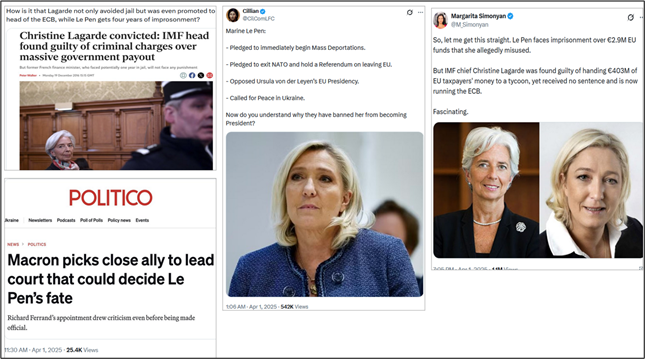
Other Orwellian cases – frightening trajectory in Europe
The EU Commission has been directly intervening in Romanian president elections as well as Moldova’s elections. Other Orwellian cases can be found in Germany, Slovakia, Hungary and Estonia. No wonder, JD Vance lambasted European leaders and decision makers strongly some weeks ago.
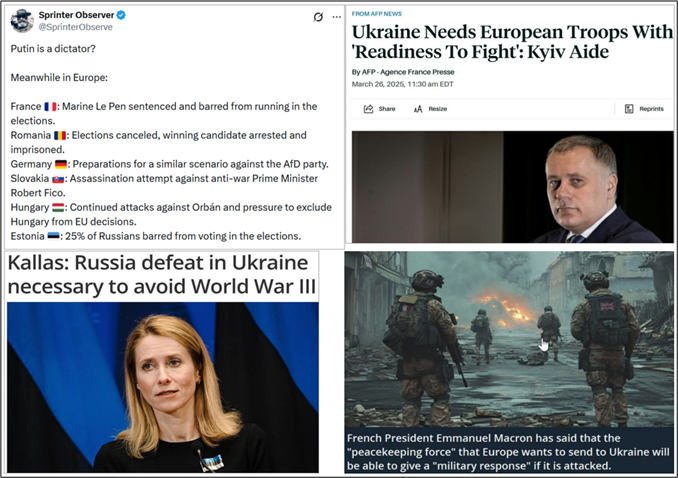
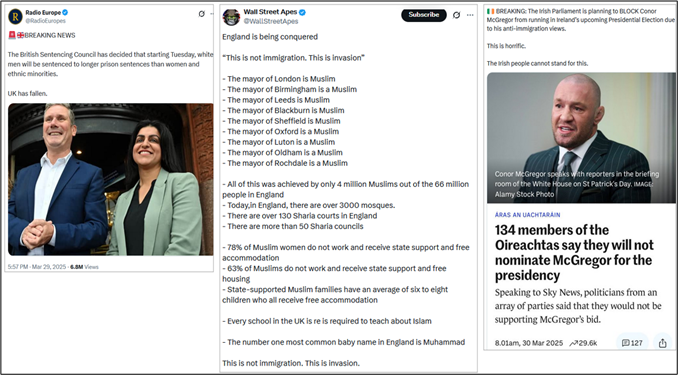
The EU Commission takes your savings – BIG BROTHER controls you
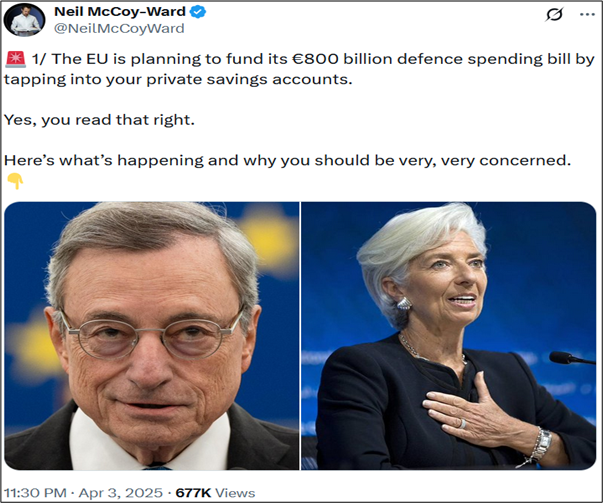

I have published an article, January 5, 2024 European tragedy: peace is lost – the pursuit of peace is untrendy which discloses “a hypocritical and double standard Europe” not caring about its basic duty for peace but turning into warmongering.
It appears that the EU, in the beginning “Peace plan for free Europe”, is turning into “Orwellian nightmarish dictatorship”, which is going to make the European citizens as brainless slaves.


